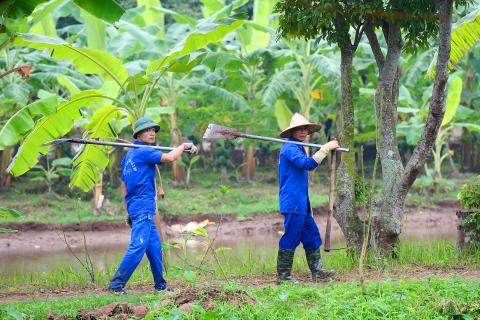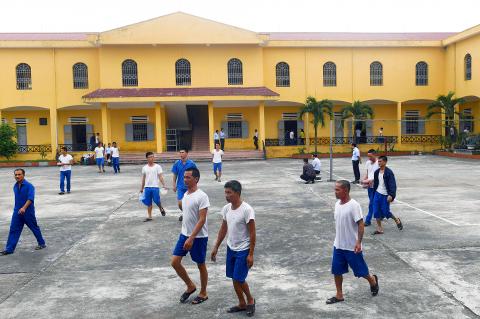During four years of compulsory rehab in Vietnam, Trung spent his drug-free days gluing together false eyelashes as part of what authorities billed as valuable “work therapy” for his heroin addiction. But critics say the work of Trung and tens of thousands of others is tantamount to forced labor that rarely helps users extinguish their addiction. Police sent Trung to a state-sponsored rehab center on the outskirts of Hanoi, one of 132 in Vietnam, where he says he faced routine beatings from guards and hours of labor for nominal pay.
“Life there, from eating, to walking, to sleeping, to working — there was no human rights at all,” explained the 50-year-old, who first began using drugs some three decades ago.
He started using again soon after his release in 2014 — up to 80 percent of addicts from the centers relapse, according to official figures. Trung’s labor therapy has since been replaced by a daily shot of methadone from a government-run drop-in clinic, which he insists is the only effective treatment he’s had. Today he says he is keeping the addiction at bay, and is trying to mend ties with his only son.

Photo: AFP
MONEY MAKERS?
Between 2014 and last year more than 65,000 addicts cycled through the centers, usually a mix of compulsory patients sent by police with those admitted by exasperated relatives. Sometimes they house other marginal groups — the mentally ill and disabled, the homeless, the elderly — along with addicts like Trung, who support the treatment model on paper even if they resent the abuse inside.
Most will stay for one or two years, or up to four if they are deemed unfit for release, and are subject to a range of daily labor — from farming cashews to making sportswear for Western clothing brands, which they can sometimes earn a meager salary from. Rights groups accuse officials at the centers of skimming from those salaries or pocketing boarding fees paid by some users’ families, and say addicts are detained against their will.

Photo: AFP
“These are a failure in terms of drug treatment, but they’re incredibly successful in terms of generating money for government functionaries who run the centers,” said Richard Pearshouse, an associate director at Human Rights Watch who authored a report about the facilities. Though similar centers exist throughout Asia, experts say the term length and the sheer number of facilities in Vietnam set it apart.
‘LOCK THEM AWAY’
Conditions inside vary widely, though several overcrowded centers have experienced mass breakouts. The government has acknowledged the need to reform the facilities and has softened drug policies, piloting community-based treatment and methadone clinics.
“Vietnamese laws and regulations are being perfected, especially when it comes to drug rehabilitation and treatment, to consider drug addicts patients,” said Le Thanh Tung, director of the Department of Social Evils Prevention in Haiphong city. The center houses some 500 addicts — mostly admitted by relatives — who after an initial period of cold turkey withdrawal behind padlocked doors are moved to dorm rooms.
Once clean, they are put to work sewing shoes or tending vegetable gardens and can receive vocational training as electricians or carpenters.
Many in Vietnam think the scheme is a good thing.
“Drug addicts do nothing good for the family or the community, they should be locked away,” said Ms Luong, mother of two heroin-addicted sons. “When you have a drug addict in your house, you live in hell. I have two as such,” she told AFP in tears.
Her sons used to pawn her furniture to fund their habit, prompting her to send one to a rehab center. She kicked the other out and hasn’t seen him in years. Like most of the 200,000 registered drug addicts in Vietnam, her sons were hooked on heroin, though methamphetamines are increasingly popular among Vietnam’s youth.
NO SILVER BULLET
Several organizations are trying to roll out community-based care to allow recovering addicts to lead normal lives, and even keep steady work. But some programs have struggled to gain traction.
“The number one obstacle for us is the lack of awareness about how complex addiction treatment is, people want to have a silver bullet,” said Oanh Khuat, executive director of the Center for Supporting Community Development Initiatives, an NGO that promotes voluntary and community-based programs. That approach is one that heroin addict Quan thinks could work for him. He spent three months and nearly US$900 on a voluntary program — another rehab option run by the government — hoping for better treatment he might have received at a compulsory center. But he quickly started using again after he left.
“The rehab model in Vietnam isn’t efficient,” the chain-smoking 46-year-old told AFP. He’s home again with his family, but jobless and getting high every day.
“We see no help, nothing from the local authorities. They have always created trouble for me, supervising me as if I was a criminal.”

President William Lai (賴清德) yesterday delivered an address marking the first anniversary of his presidency. In the speech, Lai affirmed Taiwan’s global role in technology, trade and security. He announced economic and national security initiatives, and emphasized democratic values and cross-party cooperation. The following is the full text of his speech: Yesterday, outside of Beida Elementary School in New Taipei City’s Sanxia District (三峽), there was a major traffic accident that, sadly, claimed several lives and resulted in multiple injuries. The Executive Yuan immediately formed a task force, and last night I personally visited the victims in hospital. Central government agencies and the

Australia’s ABC last week published a piece on the recall campaign. The article emphasized the divisions in Taiwanese society and blamed the recall for worsening them. It quotes a supporter of the Taiwan People’s Party (TPP) as saying “I’m 43 years old, born and raised here, and I’ve never seen the country this divided in my entire life.” Apparently, as an adult, she slept through the post-election violence in 2000 and 2004 by the Chinese Nationalist Party (KMT), the veiled coup threats by the military when Chen Shui-bian (陳水扁) became president, the 2006 Red Shirt protests against him ginned up by

As with most of northern Thailand’s Chinese Nationalist Party (KMT) settlements, the village of Arunothai was only given a Thai name once the Thai government began in the 1970s to assert control over the border region and initiate a decades-long process of political integration. The village’s original name, bestowed by its Yunnanese founders when they first settled the valley in the late 1960s, was a Chinese name, Dagudi (大谷地), which literally translates as “a place for threshing rice.” At that time, these village founders did not know how permanent their settlement would be. Most of Arunothai’s first generation were soldiers

Among Thailand’s Chinese Nationalist Party (KMT) villages, a certain rivalry exists between Arunothai, the largest of these villages, and Mae Salong, which is currently the most prosperous. Historically, the rivalry stems from a split in KMT military factions in the early 1960s, which divided command and opium territories after Chiang Kai-shek (蔣介石) cut off open support in 1961 due to international pressure (see part two, “The KMT opium lords of the Golden Triangle,” on May 20). But today this rivalry manifests as a different kind of split, with Arunothai leading a pro-China faction and Mae Salong staunchly aligned to Taiwan.